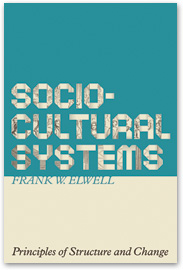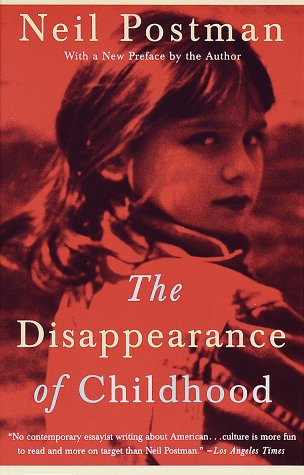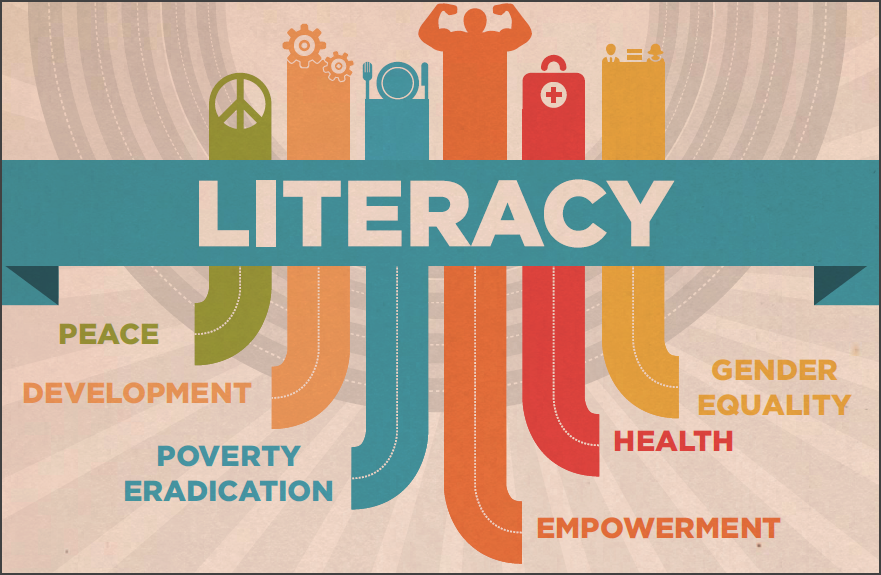
Sociocultural Systems: Principles of Structure and Change Macrosociology: Four Modern Theorists A Commentary on Malthus" 1798 Essay as Social Theory Great Classical Social Theorists In the Classical Tradition: Modern Social Theorists Dr. Elwell's Professional Page
|
rbert Spencer's Evolutionary
Sociology Neil Postman [1931-2003] | |
|
Neil Postman on the Disappearance of Childhood
By Frank W. Elwell
Postman’s social theory returns again and again to the theme of
technological change driving changes in structure and culture. He
repeatedly asserts that irrespective of the intentions of the users (or
the owners), technology always has unintended consequences, that these
consequences are both positive and negative, and that these consequences
are rarely evenly distributed throughout the society. Postman calls this
the “Frankenstein Syndrome” in which technology is developed for a
limited and specific purpose. “But once the machine is built, we
discover—sometimes to our horror, usually to our discomfort, always to
our surprise—that it has ideas of its own”(1982/1994: 21).
Inevitably new technologies cause changes in institutional structures as
well as ideas, ideologies, beliefs,
In perhaps his most provocative book, The Disappearance of Childhood,
Postman attempts to explain why the dividing line between childhood and
adulthood is rapidly eroding in contemporary society, and why the social
role of the child may well disappear in modern industrial society. His
contribution to this topic, he points out, is not in documenting this
erosion; many observers have remarked upon the disappearance in the
past. Rather, his contribution is in explaining both the origin of
childhood itself as well as the reasons for its decline. Specifically,
Postman posits that both the rise of the social role of the child and
its consequent decline is rooted in changes in communications technology
(1982/1994, xii).
The invention of the printing press and the spread of a print culture is
the primary causal agent in the rise of childhood. Replacing print
culture with an electronic medium in which imagery is the main conveyor
of information is the primary agent in its decline (xii-xiii). In a
world dominated by oral tradition, Postman states, there is not a sharp
distinction between children and adults. In such a world, childhood ends
at about the age of seven when the child has mastered speech. At the age
of seven “the medieval child would have had access to almost all of the
forms of behavior common to the culture” (15).
Save for sex and war, medieval youth would fully partake in adult life,
sharing in games, work, play, and stories. The culture did not have need
or means of keeping information away from youth. There were few secrets
between the generations; upon attaining the age of seven the youth fully
entered the adult world. Because it was an oral culture, Postman
asserts, there was no need to prolong the socialization process so that
youth can master reading and esoteric knowledge beyond the immediate
local culture; thus no need of educational institutions in which youth
are segregated from adults and age graded so that they can master both
reading and be gradually exposed to the harsher ways of the world; no
well-developed concept of shame because all have ready access to oral
information. With the invention of the printing press in about 1450 and
the spread of literacy, the “communication environment” rapidly changed.
Literacy gradually became a great divide among people; to become
literate was to become a fully functioning adult, to engage in a new
world of facts, impressions, and opinions beyond the local milieu (28).
More than this, Postman says, “typography was by no means a neutral
conveyor of information.” Rather, printing changed the very organization
and structure of thought. “The unyielding linearity of the printed
book—the sequential nature of its sentence-by-sentence presentation, its
paragraphing, its alphabetized indices, its standardized spelling and
grammar” promoted “a structure of consciousness that closely parallels
the structure of typography”(30 & 32).
With the spread of literacy, young and old began to live in different
worlds; one now had to achieve adulthood by mastering literacy and the
habits of mind it promoted. To do this, Postman adds, required the
development of institutions to provide this education, which makes the
creation of childhood a necessity (36). The relationship between the
spread of literacy, the development of schools, and the growing
conception of childhood as a part of the life cycle is incontrovertible.
Over the next few centuries adults took more and more formal control
over the socialization of youth, setting forth more stringent criteria
for the attainment of adulthood (39). The concept of childhood spreads
with mass literacy and schooling and eventually reaches the lower
classes as well. To facilitate this formal learning, youth were required
to undergo the strict discipline of the schoolhouse, to sit quietly in
neat rows, hands folded on the desk. “The capacity to control and
overcome one’s nature became one of the defining characteristics of
adulthood and therefore one of the essential purposes of education, for
some, the essential purpose of education” (46-47).
At the same time, the family gradually became organized around childhood
and schooling, and both the family and school promoted the idea of
discipline and restraint of bodily functions. Citing Elias, Postman adds
that a clear distinction was drawn between private and public behavior.
Shame and embarrassment became associated with sexual behavior as well
as other biological functions. There developed a whole vocabulary of
words deemed too sensitive for the ears of children. Adults “began to
collect a rich content of secrets to be kept from the young: secrets
about sexual relations, but also about money, violence, about illness,
about death, about social relations”(48-49).
This monopoly on the control of information and experience to the child
was maintained by a print culture in which age graded exposure to more
in-depth and complex information was carefully monitored and controlled
by the family and by the school. This monopoly was easily maintained in
that basic reading itself
But with the advent of electronic information, particularly when
television was introduced directly into the home, this monopoly
crumbled. Television, Postman points out, is a visual medium that
requires no training and is available to be viewed and understood by
all. “In learning to interpret the meaning of images, we do not require
lessons in grammar or spelling or logic or vocabulary. We require no
analogue of the McGuffey Reader, no preparation, no prerequisite
training. Watching television not only requires no skills but develops
no skills” (79). The barriers between adulthood and childhood are
eroded; there is no longer the possibility of segregating information
from the young. All are exposed to the adult world—murder and mayhem,
lust and titillation, greed and consumerism—through television melodrama
and comedy, talk shows, game shows, news shows, “reality” shows, and
commercials (80).
These shows are running on hundreds of stations twenty-four hours a day,
seven days a week. Most are competing for a wider audience and much of
this competition consists of coming up with new and novel situations,
information, and images to attract and hold that audience. Thus
television constantly seeks to push the envelope by depicting all manner
of human behavior, ideas, and lifestyles. Nothing is held back, all have
access (82). And without secrets or any sense of shame, Postman adds,
childhood must necessarily disappear. Groups are largely defined by the
exclusivity of information and knowledge that their members share,
Postman says, and adults no longer enjoy such exclusive knowledge (80).
To say that television has significantly changed the socialization
process of youth is also to make the claim that it has changed the
meaning and form of adulthood as well. It is in The Disappearance of
Childhood that Postman first broaches the themes of electronic media
changing the character of adult intellectual and emotional capacities,
emphasizing emotional responses to political candidates, consumer
products, and social issues as opposed to rational interest, logic,
reflection, and reason (50, 63, & 98).
The electronic media reduces the complexity of any subject to simple
slogans; politics becomes trivialized to personality and images. More
generally Postman asks, “What is the effect on grown-ups of a culture
dominated by pictures and stories? What is the effect of a medium that
is entirely centered on the present, that has no capability of revealing
the continuity of time? What is the effect of a medium that must abjure
conceptual complexity and highlight personality? What is the effect of a
medium that always asks for an immediate, emotional response?” (107).
More generally still, Postman asks “What is the effect on an entire
culture of a society that has given full reign to technological
progress?” It is to provide answers to these questions that drives all
of Postman’s writings (145-146). We will explore this theme further in a
future Short Essay. For a more extensive discussion of Postman's theories refer to Macro Social Theory by Frank W. Elwell. Also see Sociocultural Systems: Principles of Structure and Change to learn how his insights contribute to a more complete understanding of modern societies.
Bibliography:
Elwell, F. W. 2009. Macrosociology: The Study of Sociocultural
Systems. Lewiston: Edwin Mellen Press.
Elwell, F. W. 2006. Macrosociology: Four Modern Theorists.
Boulder: Paradigm Publishers.
Elwell, F. W. 2013. Sociocultural Systems: Principles of Structure and
Change. Alberta: Athabasca University Press.
Postman, N. (1982/1994). The Disappearance of Childhood. New
York: Random
House.
Postman, N. (1984). Amusing Ourselves to Death: Public Discourse in
the Age of Show Business. New York: Viking Penguin Inc.
Postman, N. (1992). Technopoly: The Surrender of Culture to
Technology. New York: Alfred A. Knopf.
Postman, N. (1995). The End of Education: Redefining the Value of
School. New York: Random House, Inc.
Postman, A. (2003, October 8). Eulogy for Neil Postman. New York.
To reference Neil Postman on the Disappearance of Childhood you should
use the following format:
Elwell, Frank W. 2013. "Neil Postman on the Disappearance of Childhood,”
Retrieved August 31, 2013 [use actual date]
http://www.faculty.rsu.edu/~felwell/Theorists/Essays/Postman1.htm
©2013 Frank Elwell, Send comments to felwell at rsu.edu |
 and even habits of thought. This,
Postman asserts, is generally true of technology; it is especially true
of communications technologies. For Postman, the prime movers in sociocultural change are technology and consequent changes of the
division of labor; combined, these forces change social structures and
ultimately the very character of the men and women who inhabit the
society.
and even habits of thought. This,
Postman asserts, is generally true of technology; it is especially true
of communications technologies. For Postman, the prime movers in sociocultural change are technology and consequent changes of the
division of labor; combined, these forces change social structures and
ultimately the very character of the men and women who inhabit the
society. 
 was difficult to master and literature dealing
with adult themes and privileged knowledge was of sufficient complexity
to deter children entry until they had undergone years of training in
reading, vocabulary, and syntax (79). “The maintenance of childhood
depended on the principles of managed information and sequential
learning” (72).
was difficult to master and literature dealing
with adult themes and privileged knowledge was of sufficient complexity
to deter children entry until they had undergone years of training in
reading, vocabulary, and syntax (79). “The maintenance of childhood
depended on the principles of managed information and sequential
learning” (72). 